Hints and Tips
Here are just some hints and tips baseed on common questions that we get frequently asked. Please visit our
YouTube Channel where you will find many more topical Hints And Tips.
Pine needles turning yellow and the leaves of the Indoor Elms begining to shed
Help! What should I do or Have I been doing something wrong.
Well - Don't Panic.This is perfectly natural for trees to turn yellow at this time.
This is the time of the year when Pines start to shed their old needles and for the deciduous trees to shed their leaves.
This is what we do at this time of the year. We clean the Pines by removing the old needles. Please view our video tutorials which show how to remove needles
This is what we do is September- October - remove the old Pine needles
If you see your Indoor Elms turn yellow and leaves begin to shed. This is perfectly normal too. So just dont worry -
Some Indoor Elms will take on these lovely Autumn tints come September/October. By December most of the leaves will fall, but you will get new leaves by early February
Tips for Satsukis - July/August Pruning
Pruning Satsukis
Satsuki Azaleas are best pruned after flowering in order to induce new flowering shoots for following year. Pruning also helps to maintain good shape and form of the tree. Whether the tree is small or big the pruning
principles are the same. Pruning can also be done in the early Spring, but if you prune at this time of the year, the tree will not have time to produce flowers by May or June. Pruning in the early Spring is done purely for shaping the tree.
Remove the spent flowers after flowering
Young Satsuki before pruning
Prune hard to restore the shape
Problem Trees- Spotting and Galls on leaves
We had an enquiry from someone in early October about a Sycamore that he had been growing for the past 30 years. The leaves have been developing these ugly spots each year and some of the branches were beginning to die back. He asked 'What is the problem and what should be doing to keep the tree healthy?'
Answer - This is a common problem with Sycamores - the leaves are suffering from a viral disease called Acer Tar Spot. Prevention is the best way of overcoming this disease. Collect the infected leaves and burn them. Disinfect the tree and its surrounding to kill off the virus and in Summer, spray the tree with Bordeaux mixture. Healthy trees are less likely to get this disease, so feed the tree with a balanced fertiliser or even a High Nitrogen fertiliser and this should help prevent the disease.
Winter Care of Japanese Maples
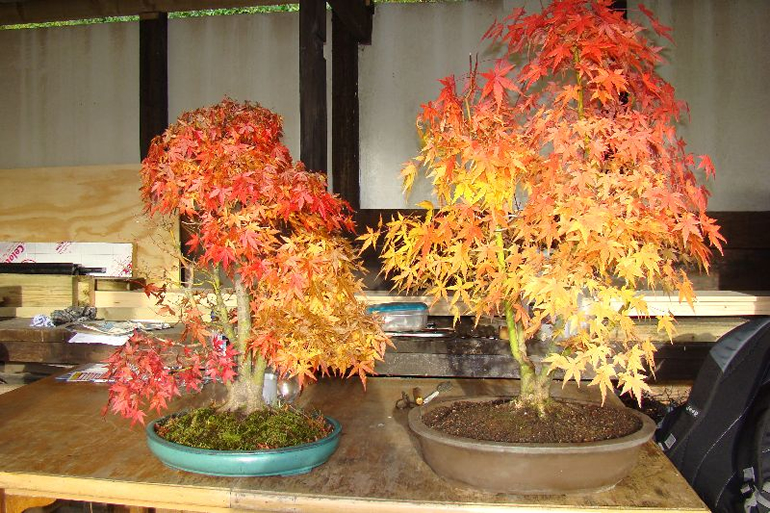
Do Maples still need watering once they have lost their leaves?
If you have not had a Japanese Maple before - you must be wondering what care they need in the Winter. Should you continue to water them once the leaves have fallen and where should you keep them when there is hard frost?
Answer
Japanese Maples are fairly hardy trees even as bonsai. You should continue to keep them outdoors as they can stand quite cold temperatures in the winter. The rain should be enough to keep the tree alive during the Winter months, but if there is a prolonged spell of dry weather then you should water the Maple so that the soil or compost is damp. If temperatures fall below minus 6 or 7C, take the tree into a shed or garage to protect it from the cold. When the temperature rises again, put the tree out in the open again.
Browining of Evergreens in Winter
In Winter many evergreen species such as the Chinese Juniper, Cryptomeria and Yews turn a sickly yellow or brown colour and many inexperienced bonsai people worry themselves silly over this. But don't panic. This is perfectly normal as all conifers turn thiscolour with the first frost. I call it 'Frost Blush' for want of a better word.
.jpg)
Here is a Chinese Juniper in December which looks a sickly yellow. Nothing wrong with it I can assure you, because this is the effect of frost. By March/April, it will turn bright green again.
If you protect your conifers under shade netting or in an unheated greenhouse, the foliage will remain green, but slight frost will not hurt. In fact frost will harden the tree and make it strong.
Cryptomerias turn reddish brown with the frost and some people like the colour as it is quite attractive.
Japanese Yews also have the habit of turning reddish brown in the Winter when the frost catches the foliage. Look at all these Yews - nothing wrong with them I can assure you. They will turn green again in the Spring. So just don't panic. All will be well.
Repotting time
February/March and early April are the best months for repotting your bonsai.
Here are a few tips for repotting if you have never done it before -
How do you know when a tree needs repotting?
You have to take the tree out of its pot and see if it is pot bound. Repot only if it is pot bound - if not pot bound - then wait till next year and examine it again. Dont repot just for the sake of repotting.
How frequently should bonsai be reptted?
Younger trees tend to grow more rapidly than older ones and certain species, such as the Maples tend to grow much faster than evergreen ones. The younger trees tend to need repotting once every two to three years while the older ones, once every three to four years - but do check the roots to see if they need it.
When is the best time to repot?
In the UK, the best time is in early Spring ie - from mid February to early April. With deciduous trees, the optimum time is when the dormant buds are just beginning to swell.
How much root to remove?
Remove about an inch all round the root ball, but not more than 30% of the soil. Dont wash or remove all the soil from the root ball as this can stress the tree un-necessarily.
What soil to use?
A reputable bonsai nursery should sell you a decent bonsai compost. Dont rely on garden centre 'bonsai compost'. Most of these are no different from ordinary garden compost. A good bonsai compost should have a good mix of gritting particles to facilitate drainage. We put 20-25% 5mm Akadama in ours along with sand, fine orchid bark and organic material such as co co fibre or peat based compost.
.jpg)
Dropping Leaves?
Leaf drop is common to all bonsai.
Leaves can turn yellow either due to not watering enough or due to insufficient light.
Also as the new leaves emerge, some of the old leaves will turn yellow and drop off.
The Ficus is no different, but your tree should not be losing all its leaves.
Some varieties like the Chinese Elm and Serissa attract Red Spider mite and this can also cause leaf drop, but Ficuses are not prone to this pest.
Make sure your Ficus is getting maximum light.
The best location is on the window sill.
During the Summer all Indoor bonsai like to be kept outdoors so that they get sunlight , fresh air and rain.
They will still need to be watered regularly (at least once a day).
If you can put your Ficus outdoors for the rest of the Summer (say till end September)
that will rejuvenate the tree and make it produce strong new green leaves.
Stop feeding it now as we are approaching Autumn, but keep it well watered.
The tips or ends of the shoots should be trimmed regularly. That will help the tree produce more side shoots.








.png)
.jpg)
.jpg)
.jpg)
.jpg)
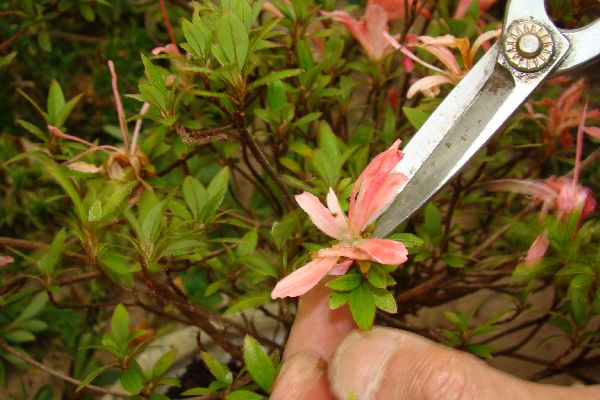
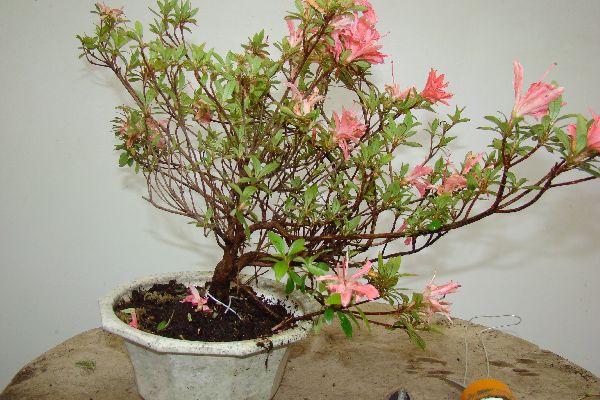
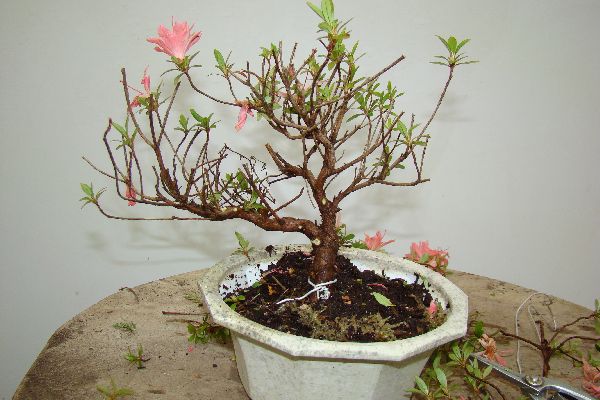
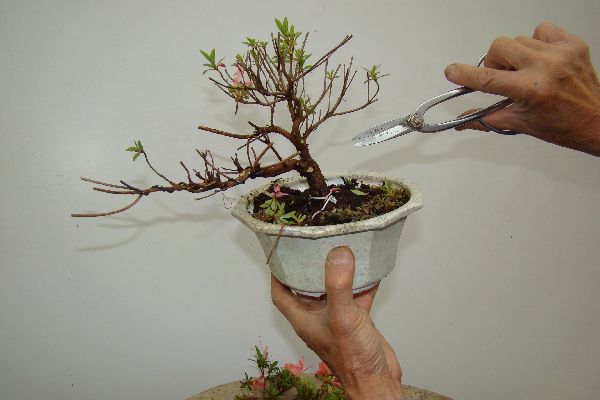
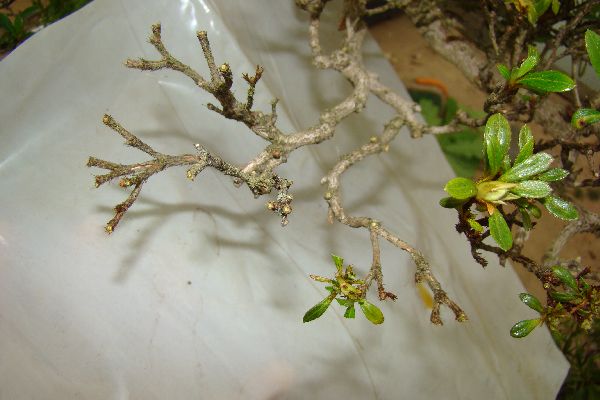
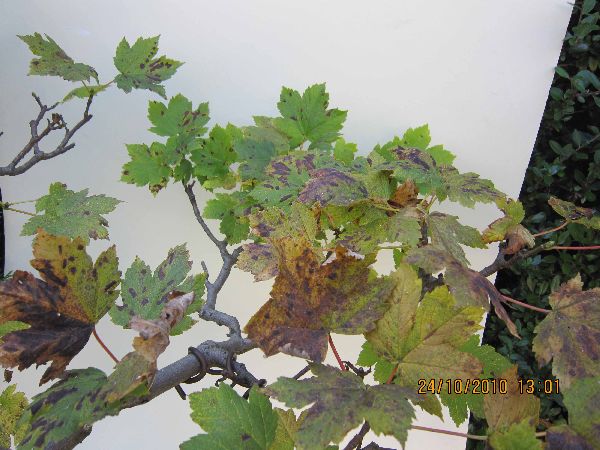

.jpg)
.jpg)






